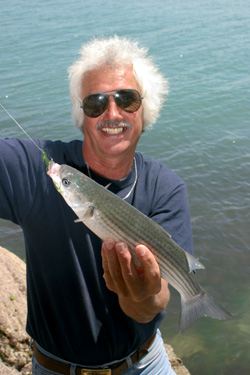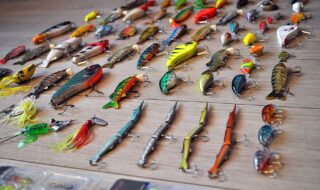Cornish rock-hopping legend Ed Schliffke is an ace at catching the elusive grey mullet.
Crafty Creatures
Mullet are notoriously crafty creatures. They’ve had many anglers stand in bewilderment, scratching their heads, as time after time they manage to take the bait off the hook without even moving the float. Lord knows how they do it, but they have the knack.
Pick Your Venue
Grey mullet frequent a whole host of marks around the UK but you’ve got to know where to look and fish if you want to catch one.
It may not be as hard as you think to find them because mullet love shallow water and they are known for showing themselves freely. I often think they swim around on the surface just to taunt us, offering up the challenge: ‘Catch me if you can!’
Apart from the traditional venues such as harbours, piers, breakwaters and river estuary tributaries, one of the harder, but more satisfying places to have a go is from the rocks.
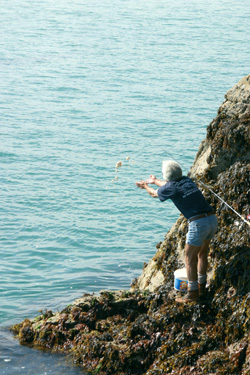 |
| Ed baits up a typical Cornish mullet mark. |
Cornwall plays host to a multitude of the said rock marks and if you ask any local angler or tackle dealer you’re bound to get the information you need to head off and have a go. Ed Schliffke is a busy chap. Apart from running a full-time bait business, he also owns a tackle shop in Padstow. As if this wasn’t enough work for one man, he also takes guided fishing parties to some of his favourite marks around the Cornish coastline. You’ll find his details at the end of this piece, and if you really want to discover the best fishing in Cornwall you should try and grab a day out with him.
Time And Tide
The next thing you need to consider is the time of year and state of the tide. Mullet are traditionally thought of as a summer species and this is true to a certain extent. However, if you really want to be in with a chance of a big one the best time to plan your attack is throughout the autumn months.
Spring or neap tides don’t really play too much of a part in how good the fishing is. The key is picking a tide either early in the morning or late evening.
Ideally you should plan to fish the tide two hours down to low water and then back up again for another couple of hours. This will give you the best chance of spotting and catching your quarry.
Grey Area Methods
By far the best method for bagging a grey mullet is to fish a light float rig set-up in conjunction with plenty of groundbait. You can leger for them but when you’re fishing from rocks in shallow water it’s far more exciting to use the float.
You’ll need to use a light spinning rod or even a 13ft match rod like the coarse guys use. Match either of these with a suitable fixed spool reel loaded with 8lb main line. Now comes the tricky bit. You must make sure that the float you choose is perfect for the job.
It’s no use going for any of the floats that you’re used to for catching mackerel, wrasse or bass – they’re far too big. No, what you need here is the subtle approach. Get yourself down to your local tackle shop and buy some insert wagglers that take around 4BB split shot to cock them.
The trick is to set the float to the required depth by locking the float onto your main line with two shot, one either side of the float, then adding the rest of the shot needed to cock the float about eight inches up from your hook.
 |
| A size 6-10 carp hook will do the job for you. |
 |
| Only half the float’s capacity goes around the base of the float. |
 |
| The rest is place like this, just eight inches from the hook. |
This method of shotting a float will ensure that your baited hook gets down into the bite zone as quickly as possible.
You’ll also need some small hooks for this type of fishing. Take a look at what the carp lads use and you can’t go far wrong. Something like a size 6, 8 or 10 will do the job.
Four Mullet Essentials
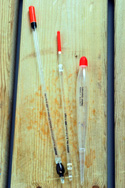 |
| Use crystal floats. |
1 Floats
Grab a selection of insert waggler floats that can take around three or four BB split shot.
2 Hooks
Go for small carp hooks like size 6, 8 and 10s. Make sure they’re chemically sharpened.
3 Split Shot
You’ll need these to lock your float onto your main line as well as for getting your bait down quickly.
4 Bread
Use yer loaf! Take some bread with you for bait. It’s cheap and very effective for mullet fishing.
Bait And Groundbait
There are many schools of thought when it comes to choosing a bait for grey mullet but there really is only one tried and tested winner – the white loaf. More mullet have been caught on bread than any other bait, so why bother confusing things. Grab yourself half a dozen cheap white loaves and you’re away.
The key to a successful day on the mullet is groundbaiting. Little and often is the rule to follow. Simply place a loaf in a bucket or bowl and add some sea water – you need to make a bread soup. Mash the bread and water well and try to break down the crusts. You don’t want to be throwing in handfuls of mashed bread that has big lumps of bread flake in it: the key is to feed your swim little and often but not actually give the mullet much food to eat.
When it comes to hook baits, a pinch of flake around the size of a 50p piece is all you need. Lay the hook on top of the bread and pinch the bread around the shank of the hook to secure it in place. A top tip here is to quickly dunk the hook into the sea prior to casting to give it a little more weight.
Getting Hooked
|
|
||||
|
|
Ed’s An Expert
So, there we were, after a 20-minute trek through some fields and a short climb down onto the rocks. Ed quickly set up his gear and began throwing handfuls of mashed bread into the sea in front of him. Within five minutes there were small shoals of mullet cruising along the weed-fringed rocks and it wasn’t long before Ed was striking and swearing.
He kept missing fish after fish as his float tip dipped under. All you would hear was the ‘swish’ as he whipped the rod tip up high into the air, followed by: “Oh baaalla**s!
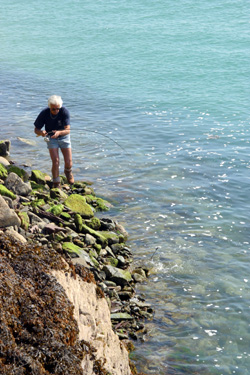 |
| Fun in the sunshine. |
Ed kept on throwing out handfuls of bread mash and he kept flicking his baited hook out into the same area, letting it drift around slowly in the tide.
Then, at last, there was a ‘swish’ from the rod, followed by a screaming drag as a hooked mullet tore off line from his reel. It wasn’t a big fish but it led him a merry dance around the rocks and weed. After a short scrap I was taking pictures of a fine grey mullet weighing about 3lb. Not a bad start, but there were some leviathans cruising about; we could see them.
In The Zone
Once Ed had hooked and landed his first fish there really was no stopping him and as the tide approached its high water mark, he had bagged three of the crafty blighters.
At high water it all went quiet but Ed continued to throw handfuls of mashed bread into the swim. We saw a group of three fish swim by, the largest Ed estimated to be around 8lb, but alas he couldn’t get it interested in his hook bait.
As the tide increased in strength on the ebb, the fishing too heated up. Ed was missing bites all over the place, so I decided to have a go myself. I tackled up Ed’s spare rod and cast in front of a group of fish to my left, the biggest of which was similar in size to the one that Ed had tried to fool. To my amazement, the larger fish swam up to my hook bait and sucked it in… then spat it out… then sucked it in again.
It continued to do this and each time it was like an electric shock running through my body as I twitched, ready to strike. But each time I froze and, sure enough, the bread was spat out. This happened about six or seven times and each time the bread hook bait got smaller and smaller as the mullet sucked little bits from it. Eventually there was next to nothing on the hook and I struck out of frustration – wrong move!
The surface erupted as four scared mullet darted off to safety! Shortly after, I had another small group of mullet in front of me and this time one of the smaller, less experienced mullet took the bait. I suppose it must have gone about 5lb. I struck into the fish, the rod tip arched over and line began to scream off my reel, but then it all went slack – I’d pulled the hook out of the fish’s mouth.
You must make sure that your drag is set fairly light when targeting mullet. They have very soft mouths and it’s easy to pull the hook out, as I found out. Well, I was gutted, but the adrenaline rush was out of this world.
After that episode I concentrated on taking pics of Ed as he managed to bag himself a further two mullet, both around the 3lb mark.
The tide was in full flow now and Ed made the decision to call it a day. I could have stayed on for hours, but Ed knows best. Maybe next time I’ll manage to land one for myself!
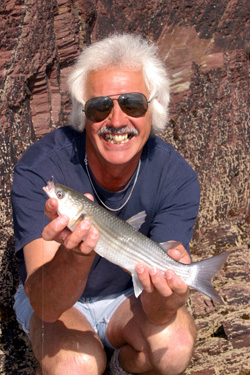 |
| Ed landed two mullet around the 3lb mark. |
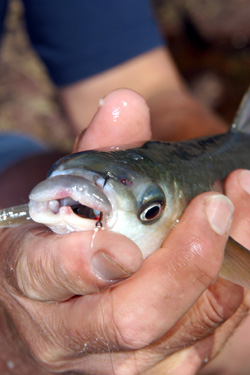 |
| They have soft mouths so make sure you have the drag set properly. |


